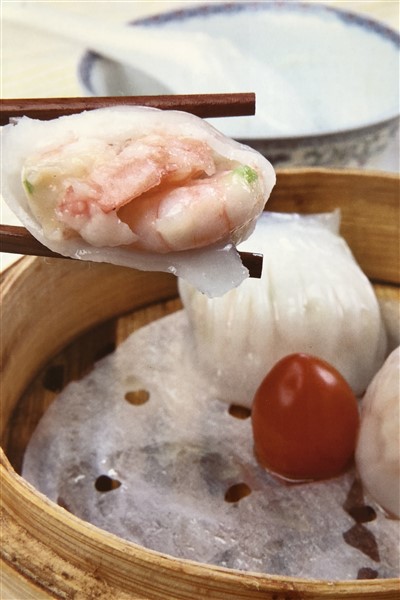Har Gow
Classic Crystal Shrimp Dumplings
With their snow-white, paper-thin skin, crystal shrimp dumplings – also known as “Har Gow” – have a similar shape as bent combs, thus giving them another name: “bent comb dumplings”. The shrimp filling gives Har Gow a unique taste. At any Cantonese dim sum house, these are the must-order signature dim sum classics.

Ingredients
- 2 cups (250 grams) wheat starch
- 1/2 cup (50 grams) corn flour
- 3/4 pound (350 grams) fresh shrimp
- 1 ounce (30 grams) fatty pork
- 1 ¾ ounces (50 grams) winter bamboo shoots
Seasonings
- 2 teaspoons (10 grams) salt
- 1 teaspoon (5 grams) sugar
- 1 teaspoon (5 grams) chicken bouillon powder
- 2 teaspoons (8 grams) cooked pork lard
- vegetable as desired/needed
Cooking Directions
Preparations
- Devein and remove shells of shrimps. Clean with fresh water. Add a bit of corn flour, spread evenly, then rinse the shrimps. Use the back of a knife to mash 1/3 of the shrimp meat into shrimp paste. For the remaining shrimp, cut each piece in two and remove water with paper towel.
- Rinse the pork and chop into granules. Wash winter bamboo shoots. Then put the bamboo shoots in boiling water and steam for a short time, then cut them into strips and squeeze out the moisture.
How to make Har Gow filling
- Add 1/2 teaspoon (3 grams) salt to the shrimp paste and knead it until it achieves a gluey consistency so that the filling will be chewy. Add winter bamboo shoots and fatty pork to shrimp paste. Add salt, white sugar, chicken bouillon powder, ground pepper and 1/2 teaspoon (3 grams) pork lard. Knead evenly to make the filling.
How to make Har Gow wrappers
- Add wheat starch to bowl. Add corn flour and 1 ⅔ cups boiling water. Stir evenly and heat. Use a bowl to close the dough and cover for 2 minutes. Rub dough evenly. Add 5 grams pork lard and rub again.
- Add a bit of cooking oil to a towel and wipe knife so that each side of the blade is coated in an equal amount of oil. Rub dough into long strips of even thickness. Cut into even pieces with knife. Reapply oil to knife. One by one, press the circular pieces of dough into thinner, circular dumpling wrappers.
How to wrap a Har Gow
(Step 6 is optional, this is how chefs do it in the restaurants. However, as long as the Har Gows stay shut, you’ve accomplished your goal.)
- Add an appropriate amount of filling to the center of the dumpling skin and fold together. With your right hand, press down on the front, middle, and back parts of the dumpling skin with your thumb, index finger, and middle finger respectively. With your left hand, use your thumb and middle finger to pinch one end of the dumpling together tightly. Use your right middle finger to constantly push out the creases in the dumpling towards the left. Use your left index finger to constantly pinch the creases together and pinch them together tightly with the back dumpling skin. After pinching the opening shut, gently pinch the side of the dumpling with creases on it so that it curves upwards, thus properly shaping the dumpling
Put it all together
- In a bamboo steamer (or just simply a steamer), lay down a sheet of oilpaper or damp gauze. Put the dumplings in the steamer with ample distance between each one. Add an appropriate amount of fresh water to the steamer pot and put the bamboo steamer on top. Bring water to a boil over high heat, then reduce to medium heat and steam for 6 minutes.
Har Gow History
Crytal shrimp dumplings, also known as Har Gow, were created by a family Dim Sum restaurant in the 1930’s in Wufeng village near the south river area in Guangzhou. It became a beloved dish of local residents due to its tasty filling made from fresh shrimps which were fished right out of the river. Har Gow gradually spread to other restaurants throughout the city of Guangzhou. Afterwards, thanks to the continuous refinements by dim sum chefs, it became an exquisitely delicious snack. By the 1970’s, Guangzhou, Hong Kong, and other regions began using frozen shrimps from Vietnam and Thailand to make crystal shrimp dumplings. Aside from the most high-end establishments which only use fresh shrimps, most other restaurants use frozen shrimps, resulting in a less fresh taste.
You may also like: